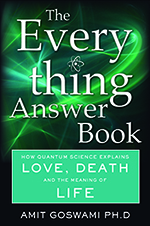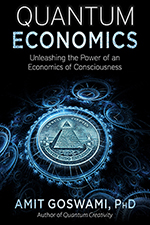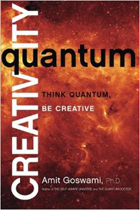Please enjoy an excerpt from Amit’s upcoming book, Sex, Love, and the New Physics.
When you write a book, you give it a tentative name, but the publishers have the right to change the name, and most often they do. In my case, for my very first book on the quantum worldview, the publisher selected a much better name than I did. I had written a compelling sentence in the book: “The universe is self-aware through us.” Perhaps this sentence influenced the person who chose the name The Self-Aware Universe. I don’t know. But it is a great name for a book that would begin a new worldview that says the universe is self-aware through us. We are important for quantum physics just as quantum physics is important for us. We can integrate the way we do physics and the way we do us. My initial mission was fulfilled. And I was happy. The year was 1993.
I started writing the book that eventually became The Self-Aware Universe in 1982. It took me some ten years to write it in the final form; for a while, I attempted to find a publisher to no avail. I gave up and wrote a textbook on quantum physics instead and published that. Then, a fellow named Richard Reed somehow saw and read the existing manuscript, liked the message; took it upon himself to go to LA and show it to Jeremy Tarcher himself, one of the great publishers of new paradigm science. Somehow, Richard succeeded, and Tarcher gave me a contract. But he did not like the initial draft. We had a long phone call. At the end, he promised to find a new editor and I promised to give him a new manuscript.
I managed to do a more inspired rewrite, and the new editor did some inspired editing. The book gelled and saw daylight. That is the superficial story behind the book.
Even before the book was published, as was the custom in science, I did write my results in the previous chapters in a paper and published it in a physics journal called Physics Essays. Imagine the odds, but a Mexican neurophysiologist was aware of my work. I got a call from him even before SAU was published.
“Professor Goswami, my name is Jacobo Grinberg. I am a neurophysiologist at the University of Mexico. My students and I have done some experiments, and I think you would be interested in our results.”
“Tell me more,” I said.
“Well, we have demonstrated, I think, the nonlocal transfer of information between brains. I also think that your theory predicts that. You should see our data and see what you think.”
“Amazing,” I thought, catching the gist of what he was saying. I confess, that I had not thought of this possibility before; certainly, if I had, then I myself would have predicted this nonlocal information transfer between brains, and the paper would have been better for it. This Jacobo Grinberg must be an extraordinary scientist.
“Dr. Grinberg, I would love to see the data. This is super.”
And so, it was arranged that I would go to Mexico City and meet Jacobo Grinberg and his collaborators at the University of Mexico. There, I checked out his laboratory, saw an experiment done before my eyes and the data analyzed. That afternoon, Leah Attie (a co-author of the article Jacobo and I wrote later; Attie was her name then) and another student took me out for a meal with a Mariachi band, and we had a wonderful time. Later that week, Jacobo and I wrote the now famous paper (coauthored with Leah and another post-doctoral associate of Jacobo) on transferred potential—transfer of electrical activity from one human subject’s brain to that of another without the exchange of signals just because the two subjects meditated with the intention of direct signal-less communication during the duration of the experiment.
The night we finished the paper, Jacobo took me to his hideout (that’s how he described it) in a forest near his house, which was just outside of the city. We talked for several hours. I don’t remember much detail of that conversation after 25 years (this was in 1992) except for this exchange:
Said I, with no little tremor in my voice, “You know, Jacobo, we are witnessing and writing about the first definitive objective machine-measured scientific evidence for the existence of God.” Jacobo looked back at me and smiled but did not say anything. But I knew by the way he received my words, the way his eyes grew large, that I could have no doubt that he completely agreed with my assessment.
My visit with Jacobo ended after I delivered a talk to interested faculty of the University of Mexico about my work on the developing quantum worldview including what Jacobo and I had done. His colleagues were just like my own at the University of Oregon, very skeptical about anything that threatened the worldview of scientific materialism. A woman said, “Okay, I cannot find a logical flaw in what you are saying about the message of quantum physics. But you know, it has to be wrong.” That about summed up the reaction of all the skeptics.
Jacobo told me on the way to taking me to the airport. “They [my colleagues] don’t like me because I also delve into Shamanism.”
I couldn’t resist, “Are you familiar with Carlos Castaneda’s work? Do you know him personally?”
“I knew him quite well at one time before he became so famous. How about you? Do you have any interest in Shamanism.”
“Yes and no,” I said. “Yes, because in the eighties, at a place called Bishop in the Eastern side of the Sierras, I had attended three different sweat lodges guided by a native American shaman named Raymond Stone.”
“Haven’t heard of him,” said Jacobo.
“Oh, he was nobody famous. It is just that Dr. Wolff recommended him as a good man. And Raymond was reverential to Dr. Wolff, whom he referred to as the ‘big shaman.’” I had told Jacobo about Dr. Wolff in an earlier conversation.
“Anything happen?”
“There were movements of what people called energy in my body that I could feel. But I don’t understand energy.” I confessed.
“These energies are real, my friend,” said Jacobo gravely. Shamans can do all kind of healing because they control these energies. I knew a shaman named Pochita. I tell you, before my very eyes, she once took a man’s heart out, fixed it, and put it back. And the man was healed from his heart ailment.”
I was dumbfounded.
“Interested in researching the subject?”
“I will think about it,” is all I said.
We published the transferred potential paper, but I never could make any headway about those “energies.” Instead, we began talking about other topics for joint investigation in neuroscience using our new model of consciousness. Eventually we wrote another paper.
The first chance I got, I invited Jacobo to a consciousness conference in Bangalore in 1993. Jacobo came with his wife, and they were a hit. The researchers in Bangalore planned to replicate Jacobo’s transferred potential experiment at long distance—with one meditator in Bangalore, the other in Mexico City.
Then Jacobo disappeared. The last time that anyone could track him down was when he went to the airport in Mexico City to board a plane to his eventual destination at Bangalore to do the preliminary work on the planned inter-continental experiment. No one has heard from him since.
Sometimes, when I am by myself, I still become a little misty-eyed and think how nice it would have been to have him with us today leading the movement toward the new science paradigm. I know in my heart that if Jacobo were still alive when the paradigm did shift, he would be awarded the first Nobel prize on the subject of consciousness studies.
But you know what, that Jaco! He didn’t care much about prizes. Always a scientist, he just wanted to satisfy himself that his vision of the enchanted world was scientific.
The good news is that his pioneering experiment has now been replicated, at last count, by some two dozen different laboratories all over the world.
An epilogue: Leah and another one of Jacobo’s students Amira Valle went ahead and published a book about Jacobo, including all of Jacobo’s work, published and unpublished. I lovingly wrote the foreword of their beautiful book.



